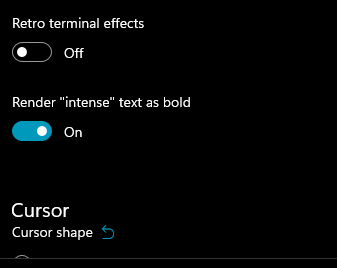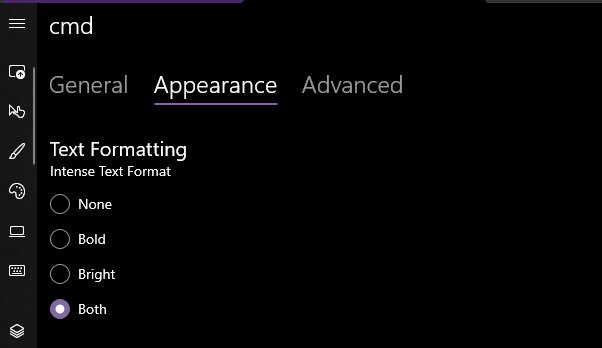-
Notifications
You must be signed in to change notification settings - Fork 8.3k
New issue
Have a question about this project? Sign up for a free GitHub account to open an issue and contact its maintainers and the community.
By clicking “Sign up for GitHub”, you agree to our terms of service and privacy statement. We’ll occasionally send you account related emails.
Already on GitHub? Sign in to your account
Consider whether we need to support "bold foreground" (like gnome-terminal) as a separate color #5682
Comments
|
This is intimately tied with the discussion in #109. |
|
In spirit of our recent cleanups to color handling (multiple issues at one place at gnome-terminal 762247), "bold color" is probably the last one standing that IMO doesn't make any sense and we should start deprecating :-D |
|
See also 686043 (italic text color), 104968 (underline text color), reverse color, blink color [these five are supported by xterm: colorBD, colorIT, colorUL, colorRV, colorBL], also xterm's italicULMode which converts underline to italic, maybe there's more. There are plenty of modes that you could implement, not sure if you should. I personally find proper bold and italic support much more important. |
|
And, to somewhat contradict my previous comments :) In VTE, During the recent color cleanup efforts (and let's also link 728600 and 793152 here), this automatic brigtening and the magic hardwired formula were removed from our code. In other comments I've already spoken up in favor of an optional mode where colors are fully separated from boldness, and such a mode should not make This, however, requires to have bold typeface, or user-specified explicit bold color. Otherwise SGR 1 becomes a no-op: neither bolder, nor brighter. (Not sure if I managed to help you, or just confused you more :)) |
You know, maybe a little bit of both! 😉 Nah, jokes aside: this is very helpful. Thanks! |
|
And the IMHO funniest bit: With Solarized, VTE's magic auto-brightening formula accidentally used to result in almost exactly another Solarized color. That's presumably why no one complained that things were conceptually wrong. (793152 comments 10-11) |
|
The whole idea of font weights and underlines affecting colours comes from the SCO Console (which inspired much of the Linux and FreeBSD kernel terminal emulations) and ECMA-48 control sequence processing that targetted CGA/EGA/VGA display hardware (including the It wasn't in the pre-CGA world, moreover. Real terminals didn't do this, and (ironically) the SCO Console would use proper underlines and boldface when the system had a Monochrome Display Adapter. This is particularly relevant when it comes to the default colour pair. Its use is often the case for programs that do not generate coloured output. Such programs might well be expecting the monochrome world, where underlines and boldface are actually underlines and boldface. My softwares maintain font weights and underlines separately from colours in their datastructures, and in the default mode render them as true font weight changes and glyph underlines on screen. There is a non-default mode that can be invoked at the final, realizer, stage (witness the This is pretty much the same ideas as M. Koblinger has been propounding, and I am another datum supporting the thesis that there is wide agreement on this nowadays. It's a post-VGA world, and control sequences for font weights, font slants, and underlines are expected to actually do those things. The places where the VGA behaviour is even used are limited. Old text files with control sequences targetting the Moreover, the only time when an ncurses/terminfo application will attempt to use boldface and blink as colour changes is if the terminal type is set to |
|
The current behaviour I’m observing in Alacritty, which I believe is coming from ConPTY (though I haven’t exhaustively checked, because that’s an exhausting effort) seems to be that just plain bold ( This has caused me to give up for now in my attempt to make my terminal light. I had contemplated working around this by swapping “black” and “white” (0 and 7, 8 and 15) but #2661 ruins my Vim colorscheme when 'termguicolors' is enabled (24-bit colour) and I am dispirited and disinclined to bump my colours by one to avoid the problem. |
|
@chris-morgan That's likely the conpty "narrowing" issue (#2661). I'm fairly certain that plain bold will be passed through as |
|
Does WT support bold currently? I haven't figured it out. Where can I use it? |
|
@schuelermine Nope, see #109: |
|
Yea #109 is more about the build text weight, while this issue is about the "bold === bright" discussion. IMO they are separate enough issues |
|
Fair 'nuff. So someone could teach the renderer to use a bold font variant to resolve #109, separately from this discussion? Makes sense to me, thanks for the clarification. |
|
Just curious: Is the overall understanding from the Windows Terminal owners that being able to disable the "bold is bright" mapping in the future would be good, and it's just a question of prioritization and blockers? Or is it still undecided if that toggle is a feature worth supporting in the first place? And, to be clear, I'm asking this independent of what happens with Issue #109. For my personal use cases, it would be lovely if "proper bold" was supported (e.g., for WSL in Windows Terminal), but honestly if I could configure the bold attribute to just be ignored for now that would be incredibly helpful (vs. bold changing text color, which can lead to hard-to-read UIs). Also, for my own understanding, is this issue just about "bold for the default foreground color" or is it also about "bold for the first 30-37 foreground color escape sequences"? The way I configure my terminals personally is for bold to never become bright, regardless of whether it's the default foreground color, a 30-37 color, a 38 indexed color, or a true color. So as a user I am really hopeful that Windows Terminal will support that behavior some day, even if not right away. :) |
…10759) ## Summary of the Pull Request This adds a new setting `intenseTextStyle`. It's a per-appearance, control setting, defaulting to `"all"`. * When set to `"all"` or `["bold", "bright"]`, then we'll render text as both **bold** and bright (1.10 behavior) * When set to `"bold"`, `["bold"]`, we'll render text formatted with `^[[1m` as **bold**, but not bright * When set to `"bright"`, `["bright"]`, we'll render text formatted with `^[[1m` as bright, but not bold. This is the pre 1.10 behavior * When set to `"none"`, we won't do anything special for it at all. ## references * I last did this in #10648. This time it's an enum, so we can add bright in the future. It's got positive wording this time. * ~We will want to add `"bright"` as a value in the future, to disable the auto intense->bright conversion.~ I just did that now. * #5682 is related ## PR Checklist * [x] Closes #10576 * [x] I seriously don't think we have an issue for "disable intense is bright", but I'm not crazy, people wanted that, right? #2916 (comment) was the closest * [x] I work here * [x] Tests added/passed * [x] MicrosoftDocs/terminal#381 ## Validation Steps Performed <!--  -->  Yea that works. Printed some bold text, toggled it on, the text was no longer bold. hooray. ### EDIT, 10 Aug ```json "intenseTextStyle": "none", "intenseTextStyle": "bold", "intenseTextStyle": "bright", "intenseTextStyle": "all", "intenseTextStyle": ["bold", "bright"], ``` all work now. Repro script: ```sh printf "\e[1m[bold]\e[m[normal]\e[34m[blue]\e[1m[bold blue]\e[m\n" ```
…10759) This adds a new setting `intenseTextStyle`. It's a per-appearance, control setting, defaulting to `"all"`. * When set to `"all"` or `["bold", "bright"]`, then we'll render text as both **bold** and bright (1.10 behavior) * When set to `"bold"`, `["bold"]`, we'll render text formatted with `^[[1m` as **bold**, but not bright * When set to `"bright"`, `["bright"]`, we'll render text formatted with `^[[1m` as bright, but not bold. This is the pre 1.10 behavior * When set to `"none"`, we won't do anything special for it at all. * I last did this in #10648. This time it's an enum, so we can add bright in the future. It's got positive wording this time. * ~We will want to add `"bright"` as a value in the future, to disable the auto intense->bright conversion.~ I just did that now. * #5682 is related * [x] Closes #10576 * [x] I seriously don't think we have an issue for "disable intense is bright", but I'm not crazy, people wanted that, right? #2916 (comment) was the closest * [x] I work here * [x] Tests added/passed * [x] MicrosoftDocs/terminal#381 <!--  -->  Yea that works. Printed some bold text, toggled it on, the text was no longer bold. hooray. ```json "intenseTextStyle": "none", "intenseTextStyle": "bold", "intenseTextStyle": "bright", "intenseTextStyle": "all", "intenseTextStyle": ["bold", "bright"], ``` all work now. Repro script: ```sh printf "\e[1m[bold]\e[m[normal]\e[34m[blue]\e[1m[bold blue]\e[m\n" ```
This PR merges the default colors and cursor color into the main color table, enabling us to simplify the `ConGetSet` and `ITerminalApi` interfaces, with just two methods required for getting and setting any form of color palette entry. The is a follow-up to the color table standardization in #11602, and a another small step towards de-duplicating `AdaptDispatch` and `TerminalDispatch` for issue #3849. It should also make it easier to support color queries (#3718) and a configurable bold color (#5682) in the future. On the conhost side, default colors could originally be either indexed positions in the 16-color table, or separate standalone RGB values. With the new system, the default colors will always be in the color table, so we just need to track their index positions. To make this work, those positions need to be calculated at startup based on the loaded registry/shortcut settings, and updated when settings are changed (this is handled in `CalculateDefaultColorIndices`). But the plus side is that it's now much easier to lookup the default color values for rendering. For now the default colors in Windows Terminal use hardcoded positions, because it doesn't need indexed default colors like conhost. But in the future I'd like to extend the index handling to both terminals, so we can eventually support the VT525 indexed color operations. As for the cursor color, that was previously stored in the `Cursor` class, which meant that it needed to be copied around in various places where cursors were being instantiated. Now that it's managed separately in the color table, a lot of that code is no longer required. ## Validation Some of the unit test initialization code needed to be updated to setup the color table and default index values as required for the new system. There were also some adjustments needed to account for API changes, in particular for methods that now take index values for the default colors in place of COLORREFs. But for the most part, the essential behavior of the tests remains unchanged. I've also run a variety of manual tests looking at the legacy console APIs as well as the various VT color sequences, and checking that everything works as expected when color schemes are changed, both in Windows Terminal and conhost, and in the latter case with both indexed colors and RGB values. Closes #11768

Many terminals optionally treat
\e[1;39mas a separate color.gnome-terminal has a toggleable "bold foreground" option:
When it's set,
1;39is different from39.The text was updated successfully, but these errors were encountered: